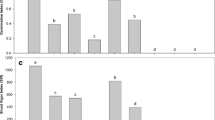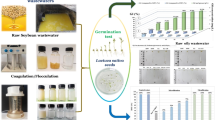Abstract
The phytotoxicity effect of olive mill wastewater (OMWW) treated in a combined system regrouping pretreatment by filtration on olive stones and coagulation-flocculation, and anaerobic digestion (AD) on seed germination of maize and tomato was evaluated through germination tests in petri dishes and growth tests in pots. Three samples, referenced as AD-40, AD-60, and AD-80, were collected from the anaerobic reactor operating with an influent at 40, 60, and 80% OMWW/water (% v/v). Concentrations between 25 and 100% were used for maize and between 5 and 25% were used for tomato using raw and pretreated samples, while anaerobic samples were used without dilution. For maize, 100% and 75% OMWW were very phytotoxic and completely prohibited seed germination, while phytotoxicity was decreased following dilution at 25% and 50% OMWW. Maize germinability was found highly enhanced when watered with anaerobic samples. For tomato, high dilution was required to reduce the phytotoxicity of raw and pretreated OMWW and a high relative germination percentage was registered at 5, 10, and 15% OMWW, while for samples anaerobically treated, a high phytotoxicity is still observed. Growth tests, showed more favorable results for maize watered with raw and pretreated samples at 25% OMWW and with biological samples. For tomato and with the exception of 25% OMWW and AD-80, seeds respond positively to all samples. It was concluded that if the OMWW will be used for irrigating maize, it could be directly used after anaerobic digestion, while for tomato further dilution is required. The phenolic profile analysis of the tested samples coupled with the results of the germination tests showed that the OMWW phytotoxicity appears to be determined by not only the monomeric phenols but also by other toxic components unaffected by the applied treatments.





Similar content being viewed by others
References
Aliotta G, Fiorentino A, Oliva A, Temussi F (2002) Olive oil mill wastewater: isolation of polyphenols and their phytotoxicity in vitro. Allelopath J 9:9–17
Altieri R, Esposito A (2008) Olive orchard amended with two experimental olive mill wastes mixtures: effects on soil organic carbon, plant growth and yield. Bioresour Technol 99:8390-8393
APHA (1992) Standard methods for the examination of water and wastewater, 18th Edition. American Public Health Association, Washington
Aquilanti L, Taccari M, Bruglieri D, Osimani A, Clementi F, Comitini F, Ciani M (2014) Integrated biological approaches for olive mill wastewater treatment and agricultural exploitation. Int Biodeterior Biodegrad 88:162–168
Arienzo M, Capasso R (2000) Analysis of metal cations and inorganic anions in olive oil mill waste waters by atomic absorption spectroscopy and ion chromatography. Detection of metals bound mainly to the organic polymeric fraction. J Agric Food Chem 48:1405–1410
Aviani I, Raviv M, Hadar Y, Saadi I, Laor Y (2009) Original and residual phytotoxicity of olive mill wastewater revealed by fractionations before and after incubation with pleurotus ostreatus. J Agric Food Chem 57:11254–11260
Ayoub S, Al-Absi K, Al-Shdiefat S, Al-Majali D, Hijazean D (2014) Effect of olive mill wastewater land-spreading on soil properties, olive tree performance and oil quality. Sci Hortic 175:160–166
Belaqziz M, El-Abbassi A, Lakhal EK, Agrafioti E, Galanakis CM (2016) Agronomic application of olive mill wastewater: effects on maize production and soil properties. J Environ Manag 171:158–165
Ben Sassi A, Boularbah A, Jaouad A, Walker G, Boussaid A (2006) A comparison of olive oil mill wastewaters (OMW) from three different processes in Morocco. Process Biochem 41:74–78
Casa R, D’Annibale A, Pieruccetti F, Stazi S, Sermanni G, Cascio B (2003) Reduction of the phenolic components in olive mill wastewater by an enzymatic treatment and its impact on durum wheat (triticum durum desf.) germinability. Chemosphere 50:959–966
Coleman R, Penner D (2006) Desiccant activity of short chain fatty acids. Weed Technol 20:410–415
DellaGreca M, Monaco P, Pinto G, Pollio A, Previtera L, Temussi F (2001) Phytotoxicity of low molecular-weight phenols from olive mill waste waters. Bull Environ Contam Toxicol 67:352–359
Dermeche S, Nadour M, Larroche C, Moulti-Mati F, Michaud P (2013) Olive mill wastes: biochemical characterizations and valorization strategies. Process Biochem 48:1532–1552
Di Bene C, Pellegrino E, Debolini M, Silvestri N, Bonari E (2013) Short- and long-term effects of olive mill wastewater land spreading on soil chemical and biological properties. Soil Biol Biochem 56:21–30
El-Abbassi A, Hafidi A, Khayet M, Garca-Payo M (2013) Integrated direct contact membrane distillation for olive mill wastewater treatment. Desalination 323:31–38
El-Abbassi A, Kiai H, Raiti J, Hafidi A (2014) Application of ultrafiltration for olive processing wastewaters treatment. J Clean Prod 65:432–438
El-Abbassi A, Saadaoui N, Kiai H, Raiti J, Hafidi A (2017) Potential applications of olive mill wastewater as biopesticide for crops protection. Sci Total Environ 576:10–21
Packed-bed biofilm reactor for semi-continuous anaerobic digestion of olive mill wastewater: performances and COD mass balance analysis. Environ Technol 6:1-13
Enaime G, Baçaoui A, Yaacoubi A, Wichern M, Lübken M (2019b) Olive mill wastewater pretreatment by combination of filtration on olive stone filters and coagulation-flocculation. Environ Technol 40:2135–2146
Fiestas Ros de Ursinos J, Borja Padilla R (1992) Use and treatment of olive mill wastewater: current situation and prospects in Spain. Grasas Aceites 43:101–106
Greco G, Colarieti ML, Toscano G, Iamarino G, Rao MA, Gianfreda L (2006) Mitigation of olive mill wastewater toxicity. J Agric Food Chem 54:6776–6782
Hanafi F, Belaoufi A, Mountadar M, Assobhei O (2011) Augmentation of biodegradability of olive mill wastewater by electrochemical pre-treatment: effect on phytotoxicity and operating cost. J Hazard Mater 190:94–99
Hanifi S, Hadrami I (2008) Phytotoxicity and fertilising potential of olive mill wastewaters for maize cultivation. Agron Sustain Dev 28:313–319
Isidori M, Lavorgna M, Nardelli A, Parrella A (2005) Model study on the effect of 15 phenolic olive mill wastewater constituents on seed germination and Vibrio fischeri metabolism. J Agric Food Chem 53:8414–8417
Jităreanu A, Tătărîngă G, Zbancioc AM, Stănescu U (2011) Toxicity of some cinnamic acid derivatives to common bean (phaseolus vulgaris). Not Bot Horti Agrobot 39:130–134
Komilis D, Karatzas E, Halvadakis C (2005) The effect of olive mill wastewater on seed germination after various pretreatment techniques. J Environ Manag 74:339–348
Lanciotti R, Gianotti A, Baldi D, Angrisani R, Suzzi G, Mastrocola D, Guerzoni M (2005) Use of yarrowia lipolytica strains for the treatment of olive mill wastewater. Bioresour Technol 96:317–322
Leather G, Einhellig F (1988) Bioassay of naturally occurring allelochemicals for phytotoxicity. J Chem Ecol 14:1821–1828
Mayer AM, Poljakoff-Mayber A, 1989 The germination of seeds. 4th Ed Pergamon Press, New York
Niaounakis M, Halvadakis CP (2006) Olive processing waste management. Literature Review and Patent Survey vol. 2nd edition
Ouzounidou G, Asfi M (2012) Determination of olive mill wastewater toxic effects on three mint species grown in hydroponic culture depending on growth substrate. J Plant Nutr 35:726–738
Paredes C, Ceggara J, Roing A, Sanchez-Monedero M, Bernal M (1999) Characterization of olive mill wastewater (alpechin) and its sludge for agricultural purposes. Bioresour Technol 67:111–115
Parvez MM, Tomita-Yokotani K, Fujii Y, Konishi T, Iwashina T (2004) Effects of quercetin and its seven derivatives on the growth of Arabidopsis thaliana and Neurospora crassa. Biochem Syst Ecol 32:631–635
Pierantozzi P, Zampini C, Torres M, Isla M, Verdenelli R, Merilesa J, Maestria D (2011) Physicochemical and toxicological assessment of liquid wastes from olive processing-related industries. J Sci Food Agric 92:216–223
Pinho IA, Lopes DV, Martins RC, Quina MJ (2017) Phytotoxicity assessment of olive mill solid wastes and the influence of phenolic compounds. Chemosphere 185:258–267
Piotrowska A, Rao MA, Scotti R, Gianfreda L (2011) Changes in soil chemical and biochemical properties following amendment with crude and dephenolized olive mill wastewater (OMW). Geoderma 161:8–17
Rejsek F (2002) Analyse des eaux: Aspects réglementaires et techniques. Scéren (CRDP AQUITAINE). Coll. Biologie technique. Sciences et techniques de l’environnement. 360p
Roig A, Cayuela ML, Snchez-Monedero MA (2006) An overview on olive mill wastes and their valorization methods. Waste Manag 26:960–969
Rusan MJM, Albalasmeh AA, Zuraiqi S, Bashabsheh M (2015) Evaluation of phytotoxicity effect of olive mill wastewater treated by different technologies on seed germination of barley (Hordeum vulgare L.). Environ Sci Pollut Res Int 22:9127–9135
Saadi I, Laor Y, Raviv M, Medina S (2007) Land spreading of olive mill wastewater: effects on soil microbial activity and potential phytotoxicity. Chemosphere 66:75–83
Saadi I, Raviv M, Berkovich S, Hanan A, Aviani I, Laor Y (2013) Fate of soil-applied olive mill wastewater and potential phytotoxicity assessed by two bioassay methods. J Environ Qual 42:1791–1801
Singleton VL, Rossi JA (1965) Colorimetry of total phenolics with phosphomolybdic-phosphotungstic acid reagents. Amer J Enol Viticult 16:144–158
Tsioulpas A, Dimou D, Iconomou D, Aggelis G (2002) Phenolic removal in olive oil mill wastewater by strains of pleurotus spp. in respect to their phenol oxidase (laccase) activity. Bioresour Technol 84:251–257
Wang Y, Yu L, Nan Z, Liu Y (2004) Vigor tests used to rank seed lot quality and predict field emergence in four forage species. Crop Sci 44:535–541
Williams R, Hoagland R (1982) The effects of naturally occurring phenolic compounds on seed germination. Weed Sci 30:206–212
Zbakh H, El Abbassi A (2012) Potential use of olive mill wastewater in the preparation of functional beverages: a review. J Funct Foods 4:53–65
Zucconi F, Pera A, Forte M, de Bertoldi M (1981) Evaluating toxicity of immature compost. Biocycle 22:54–57
Acknowledgments
This work was supported by the International Bureau of the Federal Ministry of Education and Research, Germany (IB-BMBF) within the framework of the Moroccan-German program of scientific research (PMARS).
Author information
Authors and Affiliations
Corresponding author
Additional information
Responsible editor: Gangrong Shi
Publisher’s note
Springer Nature remains neutral with regard to jurisdictional claims in published maps and institutional affiliations.
Rights and permissions
About this article
Cite this article
Enaime, G., Baçaoui, A., Yaacoubi, A. et al. Phytotoxicity assessment of olive mill wastewater treated by different technologies: effect on seed germination of maize and tomato. Environ Sci Pollut Res 27, 8034–8045 (2020). https://doi.org/10.1007/s11356-019-06672-z
Received:
Accepted:
Published:
Issue Date:
DOI: https://doi.org/10.1007/s11356-019-06672-z




